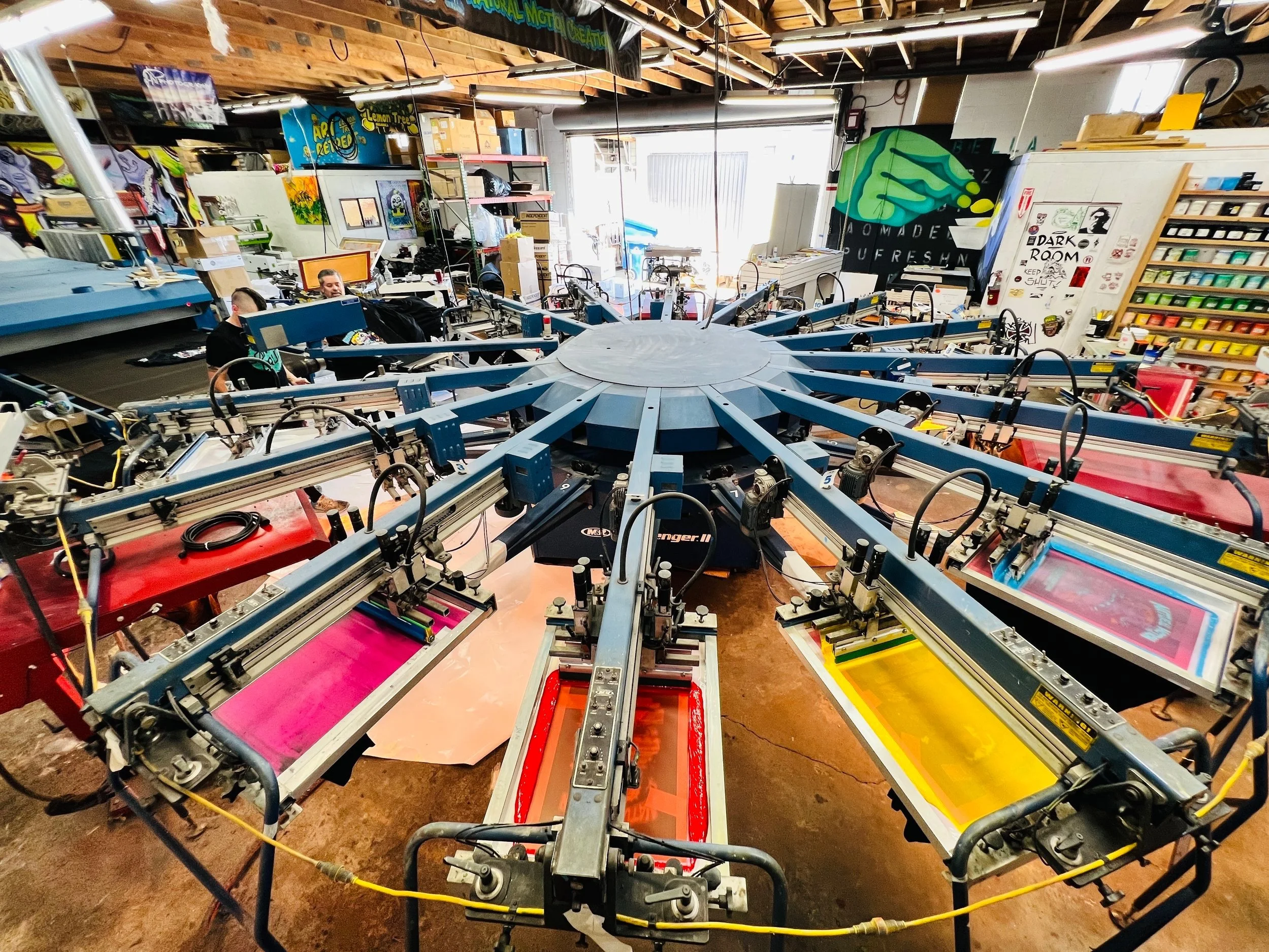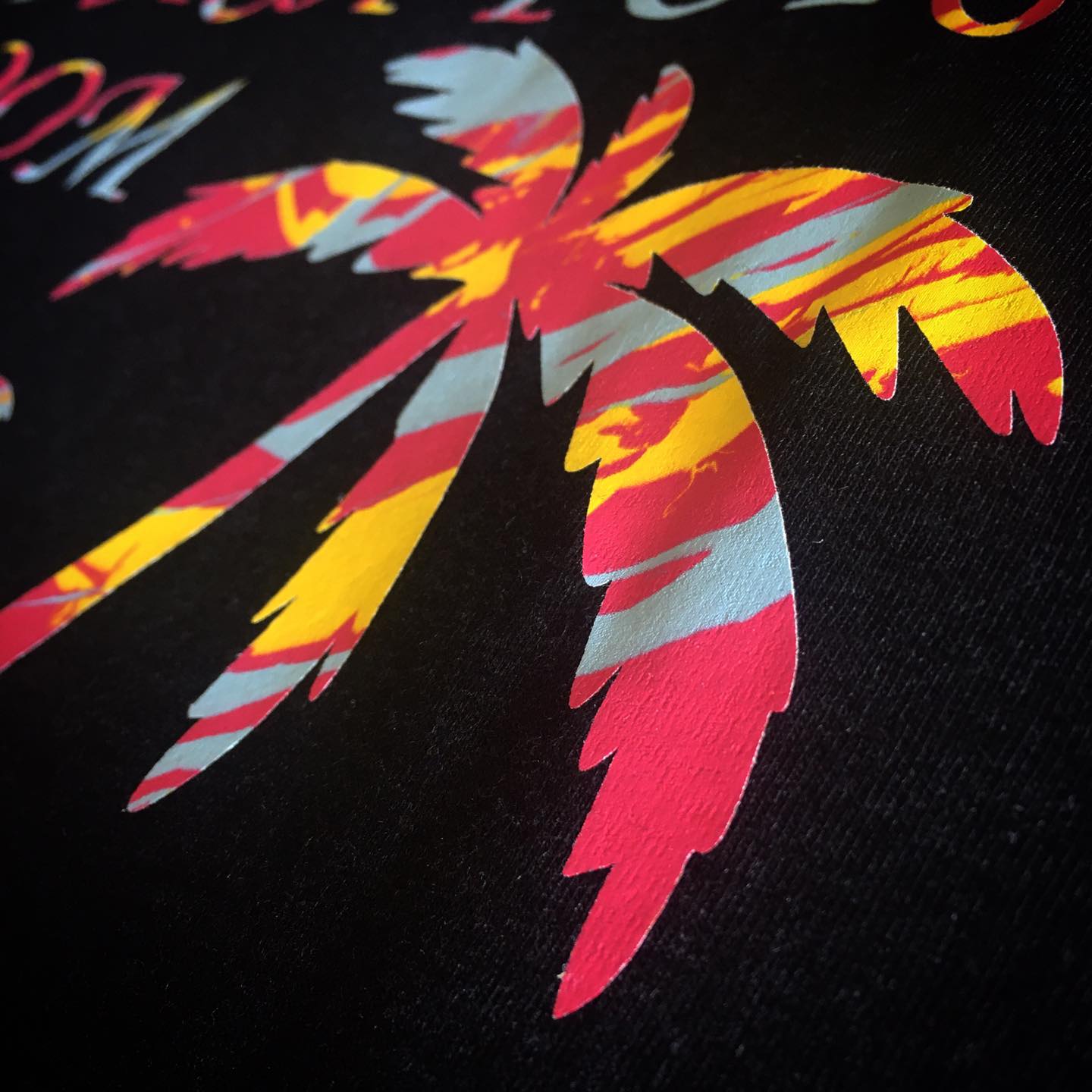High-Volume T-Shirt Printing for Schools and Organizations
Discovering the Art of Display Printing: A Comprehensive Overview to Tee Shirt Printing Techniques
When you step into the globe of screen printing, you're entering a domain where imagination meets workmanship. It's not simply about slapping ink on fabric; it's a careful procedure that requires the right tools and strategies.
The Basics of Display Printing: Recognizing the Refine
Screen printing, usually called serigraphy, is a flexible strategy that allows you to move designs onto numerous surface areas. To begin, you'll first require to create a stencil, which works as the structure for your style. This involves using a light-sensitive emulsion to a display and subjecting it to light, where your artwork blocks the light from setting the solution.
Once you've rinsed the unexposed locations, you'll have a pattern ready for printing. Next off, you place the screen on your chosen surface, like material or paper. You after that use ink on top of the display and utilize a squeegee to push the ink with the pattern onto the surface area listed below. After printing, you'll need to cure the ink to assure it adheres correctly. Understanding these standard steps sets the phase for producing vibrant, lasting styles through the art of display printing.
Important Devices and Products for Display Printing
To get started with screen printing, you'll require some essential devices and products. From the right equipment to the inks and solutions that bring your styles to life, each component plays a necessary role. Let's discover what you need to prosper in this innovative process.
Display Printing Tools
While diving into the world of screen printing, you'll find that having the best devices is crucial for attaining high-quality results. Beginning with a durable screen printing frame, which holds the mesh that moves ink onto your material. You'll additionally require a squeegee for pressing the ink with the mesh. A high quality direct exposure system is important for creating sharp designs when revealing your screens. Do not fail to remember a washout station for cleaning your screens after printing. Additionally, safety equipment like gloves and masks is essential for your safety. Finally, invest in a dependable warmth source, such as a heat press or conveyor dryer, to treat your prints successfully. With these tools, you're well on your means to understanding screen printing!
Inks and Emulsions
Selecting the right inks and emulsions is necessary for attaining sturdy and lively prints. You'll desire to pick inks based on your desired surface and textile type. t-shirt printing. Plastisol inks are popular for their ease of use and great opacity, while water-based inks use a softer feeling and are much more environmentally pleasant
Emulsions function as a light-sensitive layer on your screens, critical for developing sharp stencils. Make sure to pick a top notch emulsion that matches your ink type; some solutions function better with plastisol, while others are perfect for water-based inks. Appropriate curing is likewise important; it ensures the ink sticks well and takes on washing. By investing in the right inks and emulsions, you'll boost your display printing game substantially.

Devices for Application
After picking the ideal inks and solutions, the following action is collecting the devices and materials that will help you apply them successfully. You'll need a tough screen, ideally constructed from light weight aluminum or wooden frameworks, in addition to a great mesh for proper ink transfer. A squeegee is essential for applying pressure and spreading ink uniformly throughout the display. Don't forget a trusted exposure device to assist you create crisp patterns. Additionally, a registration system will certainly assure your layouts straighten flawlessly on each tee shirt. You'll additionally want a washout station for cleaning up screens after use (t-shirt printing). Spend in top quality handwear covers and aprons to maintain your workspace clean and safeguard yourself from ink stains. With these devices, you'll be well-appointed for effective display printing!
Typical Display Printing Strategies
Traditional display printing methods have stood the examination of time, showcasing the art and workmanship behind this popular approach. As soon as you've prepared your style, you'll use a light-sensitive solution to the screen and reveal it to a light resource, hardening the emulsion where you desire ink to flow.
After rinsing the unexposed solution, you're entrusted to a stencil. You'll then position your display on the tee shirt, apply ink on top, and use a squeegee to press the ink via the mesh. This process can be duplicated for multiple colors, calling for separate screens for every. The outcome? Vibrant, long lasting designs that showcase your creativity. Mastering these techniques provides you a strong foundation for all your display printing ventures.
Modern Innovations in T-Shirt Printing
Today's t-shirt printing landscape is humming with interesting advancements that are changing just how you create designs. With advancements in electronic printing, green materials, and advanced modification technologies, you can generate distinct, sustainable t shirts like never ever before. Allow's check out these contemporary methods and see just how they boost your printing experience.
Digital Printing Improvements
As digital printing technology has actually progressed, it's changed the landscape of Tees printing, providing you unprecedented accuracy and imagination. Direct-to-garment (DTG) printing allows you to publish directly onto fabric, making it ideal for tiny runs or personalized styles. With developments in ink quality, you can expect longevity and washability that equals screen printing.
Eco-Friendly Products Usage
While exploring modern technologies in Tees printing, you'll uncover an expanding emphasis on eco-friendly materials that focus on sustainability without sacrificing top quality. Lots of brands currently use natural cotton, which minimizes pesticide usage and promotes much healthier farming practices. Recycled polyester, made from plastic containers, supplies a sturdy alternative that decreases waste. In addition, water-based inks are getting appeal, as they create less damaging overflow compared to traditional solvent-based inks. These inks are not only safer for the environment but also offer dynamic shades and soft appearances on fabric. By selecting these products, you add to a much more lasting garment industry while still enjoying trendy, high-grade T-shirts. Accepting eco-friendly alternatives permits you to express your worths via your wardrobe.

Customization Technologies Advancement
You now have access to electronic printing methods like Direct-to-Garment (DTG) and Dye-Sublimation, which allow for vivid colors and complex layouts. These innovations make it simple to produce distinctive items without the high costs of standard display printing. Additionally, on the internet design platforms equip you to picture your concepts before printing.
Choosing the Right Ink for Your Styles
Just how do you choose the best ink for your display printing designs? Start by taking into consideration the kind of material you're working with. For cotton, water-based inks are suitable as they take in well and offer a soft feel. If you're publishing on synthetic materials, plastisol inks use browse around here resilience and lively shades.
Following, believe about the finish you desire. Matte inks provide a subtle appearance, while shiny inks can add a striking shine. If you're going for eco-friendliness, select soy-based or water-based inks, which are better for the atmosphere.
Do not neglect about color mixing; some inks can be blended to create one-of-a-kind tones. Test your inks on sample textiles to confirm compatibility and look before beginning your major task. Eventually, the right ink can make a significant difference in the quality and long life of your designs, so pick carefully!
Tips for Creating Stunning Tee Layouts
Developing sensational tee shirt layouts begins with a clear idea that resonates with your audience. Bear in mind, simpleness frequently works best; cluttered styles can confuse audiences.
Incorporate typography that shows the individuality of your brand-- select typefaces that are understandable yet elegant, and mix them intelligently. Take note of placement; the layout needs to stream naturally with the t-shirt's form.
Try out different designs, such as vintage or modern-day, to discover what fits best. Do not shy away from utilizing unfavorable area efficiently; it can develop a striking visual impact.
Finally, get comments! Share your designs with good friends or possible clients to evaluate their responses (t-shirt printing). Their insights can guide you in fine-tuning your work, guaranteeing your final design is not just spectacular but also market-ready
Fixing Common Display Printing Challenges
When you encounter challenges in screen printing, determining the root reason can make all the difference. Examine your display for correct tension and verify your emulsion is completely cured if you observe incomplete prints. For smearing or blurry pictures, maybe because of inappropriate ink thickness or inadequate treating time; change your ink or remedy settings as necessary.
If you're handling color inequalities, confirm your ink mixing ratios and validate your screens are clean and free of residue.
Lastly, if you're experiencing lifting or peeling, think about the kind of textile you're making use of and the heat used throughout curing; different materials call for particular inks and temperature levels. By dealing with these common issues systematically, you'll boost your outcomes and boost your confidence in display printing. Maintain experimenting, and don't wait to connect to fellow printers for suggestions and suggestions.
Frequently Asked Concerns
Can I Evaluate Print on Material Besides T-Shirts?
Absolutely, you can evaluate print on different materials besides tees! Think about things like tote, hoodies, or also table linens. Simply assure you're making use of the appropriate ink and equipment appropriate for the material kind.
Just how Do I Tidy and Keep My Screen Printing Tools?
To clean up and keep your display printing devices, on a regular basis clean screens with water and suitable cleansers, examine mops for damages, and store whatever in a completely dry, dust-free environment to prolong its lifespan and ensure top quality prints.
What Is the Typical Expense of Beginning a Screen Printing Company?
Starting a screen printing business generally sets you back between $2,000 and $10,000. You'll need tools, materials, and a work area. It's necessary to spending plan sensibly and plan for added helpful hints expenses as your company expands.
Is Display Printing Eco-friendly?
Display printing can be ecologically friendly if you choose eco-conscious inks and sustainable materials. By taking on finest techniques and decreasing waste, you can decrease your effect while creating vivid, high-grade prints that interest aware view consumers.
Just How Can I Advertise My Customized Tee Shirt Layouts Effectively?
To promote your custom tee designs successfully, leverage social networks systems, work together with influencers, run targeted advertisements, and engage your target market via free gifts or competitions. Regular branding and top quality visuals will certainly bring in even more clients.
Checking out the Art of Screen Printing: A Comprehensive Guide to Tee Shirt Printing Techniques
Begin with a sturdy display printing structure, which holds the mesh that moves ink onto your textile. By spending in the best inks and solutions, you'll boost your display printing video game significantly.
With innovations in ink high quality, you can anticipate durability and washability that measures up to screen printing.How do you pick the ideal ink for your display printing designs?